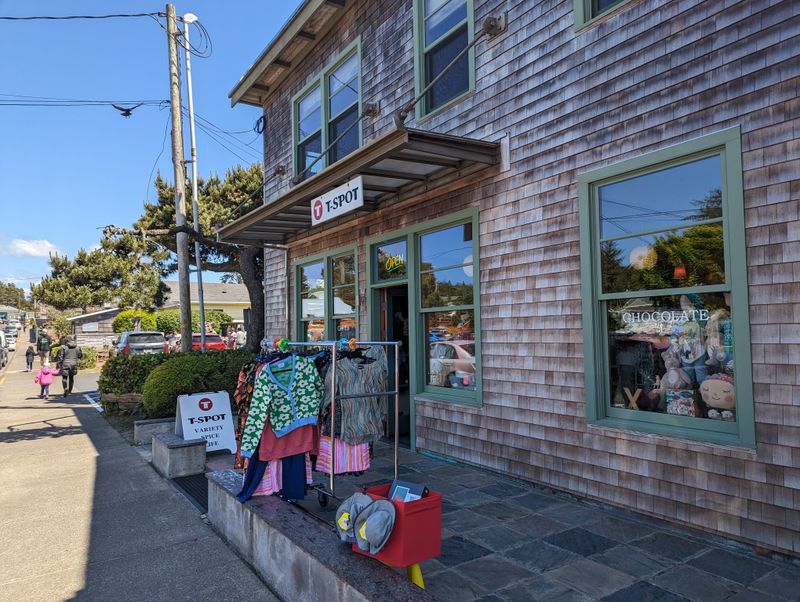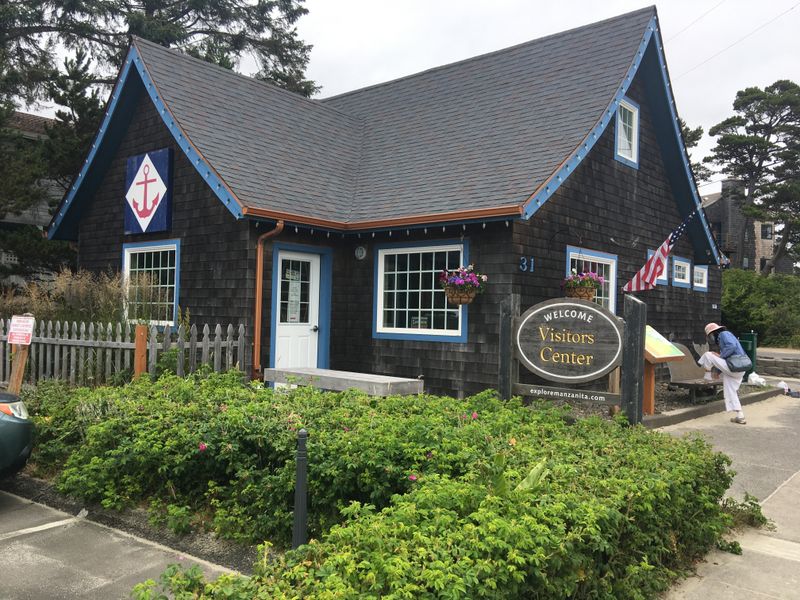Salt air greets you before the ocean comes into view, and the pace shifts the moment Neahkahnie Mountain rises over the last bend into Manzanita.
The village looks small from the highway, but the beach unfurls in a broad sweep that feels almost private, even on busy days along the Oregon Coast.
Streets lined with evergreens and low roofs keep the horizon wide and the mood gentler than neighboring hubs, inviting slower steps and longer glances.
By the time you hear the surf roll and pull in steady rhythm, you know you have arrived somewhere that rewards quiet curiosity.
Manzanita Beach at First Light

Dawn along Manzanita Beach softens every edge, and the shoreline stretches like a pale ribbon under a cool Oregon sky.
Low tide exposes a mirror of wet sand where clouds drift twice, once overhead and once underfoot.
Your steps land quietly, and gulls write their own script along the foam, then lift like paper kites.
From this wide vantage, Neahkahnie Mountain looms to the north, turning from ink to charcoal to moss as the sun loosens the morning.
The beach feels endless in this light, and the wind carries hints of spruce and salt across the open plain.
If you stand still, the rhythm of waves becomes a clock that forgets the hour.
Even on winter days, the color palette stays delicate, trading summer’s bright blues for pearl and smoke.
Beachcombers move like distant punctuation marks, and dogs trace delighted arcs that vanish in the wash.
Kelp fronds tangle near the dune line, and tiny shorebirds flick between bubbles with near mechanical focus.
No single view dominates, which makes space for your own pace and your own angle.
Some mornings bring fog that presses close yet never smothers the sound of the ocean.
Other mornings reveal a horizon so clean that boats sketch brief threads and disappear.
Here, the Oregon Coast feels open and domesticated at once, grand but not theatrical.
The flatness invites kite strings, sand runners, tide charts, and meandering conversations that drift like the foam.
When the sun finally lifts above the trees behind the village, the sand warms and the day gathers itself without hurry.
Neahkahnie Mountain’s Mighty Shoulder

Neahkahnie Mountain leans over Manzanita like a guardian, anchoring the scene and shaping weather, mood, and orientation.
The slope holds dense coastal forest that smells of cedar and rain, even after dry spells.
From the road pullouts, the beach arcs like a compass needle, and the village rests as if cupped in a palm.
Trails on the south side climb gradually through huckleberry and salal, with glimpses of surf punching through the trees.
Switchbacks keep the pace steady, and birdsong folds into the wind that funnels through the branches.
At overlooks, the Pacific unfurls without obvious edges, and cloud shadows pour across the water like ink.
The mountain’s name threads through Oregon lore, and stories of hidden treasure linger even if gold never appears.
What you do find is a sense of scale that reorders priorities and brightens small details below.
Manzanita’s grid looks almost delicate from above, and the beach reads as a thin line, not a vast room.
The climb feels accessible in most seasons, though boots make sense when the trail turns slick.
Mist sometimes drifts in fast, turning the ridge into a puzzle that rewards patience.
On clear days, sunlight shards off the ocean and throws reflections onto bark and fern.
This vantage point clarifies how the village and landscape collaborate rather than compete.
The headland blocks stronger winds and frames sunsets that linger long past the last glow.
Descending back into town, you carry the mountain’s calm with you, a quiet weight in the pocket.
Laneda Avenue’s Easy Stroll

Laneda Avenue runs straight to the sea, and the walk carries a sense of gentle momentum that fits the village’s scale.
Shops sit close to the sidewalk with warm wood, hand lettered signs, and windows that reflect a changing sky.
You do not rush here, because the street itself slows your stride and invites short pauses.
Some storefronts showcase local makers, with ceramics, coastal prints, and textiles shaped by Oregon light.
Others prioritize practical needs like rain layers, trail maps, and sturdy mugs for a rental kitchen.
Side streets hold flowers that somehow resist seaside wind and salt during calmer stretches.
At the west end, the avenue opens to the dune, and the crash of waves replaces traffic noise within a few steps.
Dogs lead the way most days, and bicycles lean against railings with quiet confidence.
Even when visitors fill the sidewalks, the mood stays friendly and unhurried.
Small conversations rise and fall, often about weather, trail conditions, or the tide’s mood.
Benches offer quick breaks for people watching and a glimpse of the horizon between buildings.
Lanterns glow during dark months and lend the street a village feel rather than a resort tone.
The architecture keeps to low heights, preserving sightlines and steady breezes from the ocean.
At midday, sunlight bounces off pale facades and pools in spots shielded by trees.
By evening, the wind usually softens, and the walk back toward the mountain feels like closing a book.
Nehalem Bay State Park’s Quiet Loops

Just south of town, Nehalem Bay State Park narrows the world to bay, dune, and ocean with a ribbon of trail between.
The bike path curves in easy loops that suit meandering exploration rather than speed or distance goals.
You pass stands of shore pine, then open sand, then splashy views of the bay where kayaks trace quiet arcs.
Deer sometimes appear near the edges of campsites, and their stillness sets the tone for the whole place.
Wind shapes the dunes into soft shoulders that shift week by week, carrying subtle patterns like ripples on stone.
Camping here feels close to Manzanita yet separate enough for deep sleep under moving branches.
The trail network allows simple choices, and you can shorten or lengthen a loop without losing orientation.
Salt grass scrapes lightly along the pathway, and the air changes character as you cross between waters.
On calm days, the bay turns glassy while the ocean side continues its steady engine of waves.
Kite flyers gather on broad stretches where space and breeze meet in perfect alignment.
Picnic tables tuck into pockets with windbreaks that matter on brisk afternoons.
Sunsets out here tilt gold, then pink, then a lingering silver that carries you back to town.
Birdlife stays active, from osprey circling high to shorebirds moving in musical unison near the tide line.
The simplicity of the park’s layout keeps decisions easy and lets views take the lead every time.
Return by twilight, and the silhouettes of pines create a gentle procession that feels ceremonial and kind.
Storm Watching From The Dune

When winter storms roll in, Manzanita’s dune becomes a safe balcony above the spectacle.
Clouds stack like mountains, and the ocean throws white ladders against the gray wall of horizon.
Staying back from the surge keeps the drama framed and the experience comfortable.
Rain gear matters more than bravery, and a thermos helps keep focus as the wind needles the cheeks.
Gusts sweep the grass into quicksilver bands that race across the dune crest.
Every few minutes, a break in the sky scrubs light over the water and reveals shifting color fields.
Locals know to check conditions and watch for sneaker waves, which can muscle up beyond expectations.
The village sits close enough for a quick retreat if weather turns unruly and vision tightens.
From this height, you notice the rhythm under the chaos, with sets pulsing in patient patterns.
Sand lifts and skims along the surface like smoke, then settles in new contours by nightfall.
Even if the forecast discourages beach time, the view from the dune keeps the day compelling.
After the front passes, air clears to a shine, and colors sharpen across Oregon’s rugged edge.
Waves shrink, surfers reappear, and dogs dash out to claim fresh territory on the flattened shore.
Storm watching here feels less about adrenaline and more about observation and respect.
You leave with the sense that weather is a neighbor with moods rather than a simple backdrop.
Oswald West State Park’s Forested Miles

North of Manzanita, Oswald West State Park offers a different register, where forest hush overtakes surf noise.
Trails slide under spruce and hemlock, and the ground drinks water in a way that muffles footfall.
Bridges cross clear creeks that run fast after rain and sparkle during brighter spells.
Short Sand Beach sits in a bowl of rock and trees, a pocket cove that feels hidden yet easy to reach.
Families, surfers, and photographers share space without crowding because the setting encourages patient rhythms.
Moss hangs in quilted layers, and every stump looks like a miniature landscape study.
The park’s layout maintains a protective buffer around steep slopes and fragile understory.
Even the parking areas reflect an Oregon preference for modest structures that let trees lead.
On misty days, droplets string along spider webs and glow like tiny bulbs in the dim light.
In brighter weather, the canopy filters sun into a gentle green that flatters every surface.
Walking here pairs well with time in Manzanita because it offers contrast without distance.
The return to town feels like surf turning up the volume again after a quiet interlude.
Trail etiquette stays simple, and narrow sections reward single file patience.
Rocky viewpoints offer framed glimpses down-coast toward the long beach that defines the village.
By the time you leave, shoelaces are damp and the mind is rinsed clean by trees and time.
Sunset Ritual On The Sand

Evening gathers differently in Manzanita, and the beach becomes a long living room where everyone respects distance.
People arrive in small groups, each choosing a pocket of sand that frames the horizon just so.
Voices drop as the sky starts to mix colors, and the day seems to exhale in relief.
Neahkahnie Mountain holds the north like a steady bookmark that keeps the page from turning too fast.
On some nights, clouds add texture that catches light in surprising seams and channels.
On other nights, the air clears completely and the palette leans toward apricot and rose.
Photographers kneel over wet sand to capture reflections that make the beach feel twice as wide.
Kids chase the retreating edge of foam, then sprint back squealing when a larger wave advances.
Kites hover low as winds ease and lines loosen with the fading day.
Your attention settles naturally on the waterline where color meets motion and time thins.
The last light lingers along the dune grass, and the village lights come on in quiet clusters.
Cooler air nudges sweaters back on, and the walk toward Laneda grows brisk enough to feel welcome.
This ritual repeats year round in Oregon, drawing both locals and visitors like tide.
No single sunset matches another here, yet each feels familiar by the second or third visit.
You leave the sand with a gentler stride and a mind tuned to slow frequencies.
Tide Pools Near The North End

At lower tides near the north end, rocky pockets reveal small worlds that hide beneath daily waves.
Anemones open like quiet flowers, and mussel shells flash blue when water slides away.
Barnacles roughen every available surface, making each step a decision rather than a thoughtless stride.
Patience pays here, because creatures respond slowly, and your stillness becomes permission to observe closely.
Foot placement matters, both for safety and to protect living spaces under the thin film of water.
A flashlight helps on gray days, because even dim pools hold color that blooms with a little light.
The ocean’s smell sharpens around seaweed beds, and bubbles snap when your shadow crosses the surface.
Waves can nudge further than expected, so keep an eye on sets and your return path to dry sand.
Each pool offers its own pattern, with pebbles, glassy shrimp, and tiny snails working slowly.
Kids tend to find wonder quickly, but adults usually settle into the same absorbed focus after a few minutes.
This edge of Manzanita feels slightly wilder because the mountain shoulder tightens the beach.
The environment here teaches gentle touch, light steps, and short visits that do no harm.
Oregon’s coastal rules support that approach, and signs in nearby parks explain why it matters.
Once the tide turns, water erases footprints and resets the stage with patient consistency.
You return to the open flat with a pocketful of new textures in your memory.
Winter Quiet In The Village

Off season brings a softer tempo to Manzanita, and rain polishes the streets into reflective threads.
Storefront lights glow earlier, and the sound of surf carries further without summer chatter.
Mornings often arrive with low clouds that sit on the mountain and velvet the edges of roofs.
Walking Laneda in this weather feels meditative, with puddles stitching small galaxies across the pavement.
You notice indoor details, like the warmth of wood trim and the steady hum of a kettle behind glass.
The village looks inward without closing, keeping doors open for steady travelers who appreciate calm.
Beach walks turn brisk and focused, and gloves make conversations shorter but more deliberate.
Windows fog and clear in slow cycles that match the push and pull of the tide.
Evenings encourage early dinners and reading nooks rather than long itineraries.
The ocean remains the main event, but the frame changes to grayscale with elegant restraint.
Visitors who return in winter often claim the season as their favorite in Oregon.
The lack of crowds reveals how small the place truly is, and how well it holds silence.
Lanterns mark thresholds, and the scent of wet cedar lingers at every corner.
By night, the village seems to hover between forest and surf like a thought not fully spoken.
You sleep deeply while rain writes soft patterns on the roof and resets the air by morning.
Finding Your Bearings And Leaving Light Footprints

Manzanita is easy to navigate, with the beach as west, the mountain as north, and the bay curving to the south.
Laneda Avenue runs the spine of the village, and most essentials sit within a short, walkable radius.
Using feet or bikes keeps stress low and helps the town stay quiet for everyone who lives here.
Parking near the dune fills early on bright days, but side streets usually offer reasonable options with patient loops.
Restrooms near the beach access points simplify longer visits and help protect the delicate dune system.
Pack out everything, and avoid trampling grass that stabilizes the sand against winter wind.
Leashes preserve wildlife and keep the shoreline peaceful when families and dogs share space.
Tide charts inform smarter plans, especially for exploring the north end’s rocky pockets.
When fog thickens, landmarks shrink, so note your entry point and keep an eye on wind direction.
Small gestures like staying on established trails prevent erosion that spreads quickly in coastal settings.
Oregon’s public shoreline ethic thrives when visitors respect both scenery and neighbors.
That approach also leaves room for birds that nest in quieter stretches during certain months.
If you need updates, the city website posts guidance and links to regional resources.
Finding bearings here becomes second nature after a single day spent watching the horizon.
You leave with better habits and a clearer sense of how people and landscape fit together.
Dear Reader: This page may contain affiliate links which may earn a commission if you click through and make a purchase. Our independent journalism is not influenced by any advertiser or commercial initiative unless it is clearly marked as sponsored content. As travel products change, please be sure to reconfirm all details and stay up to date with current events to ensure a safe and successful trip.